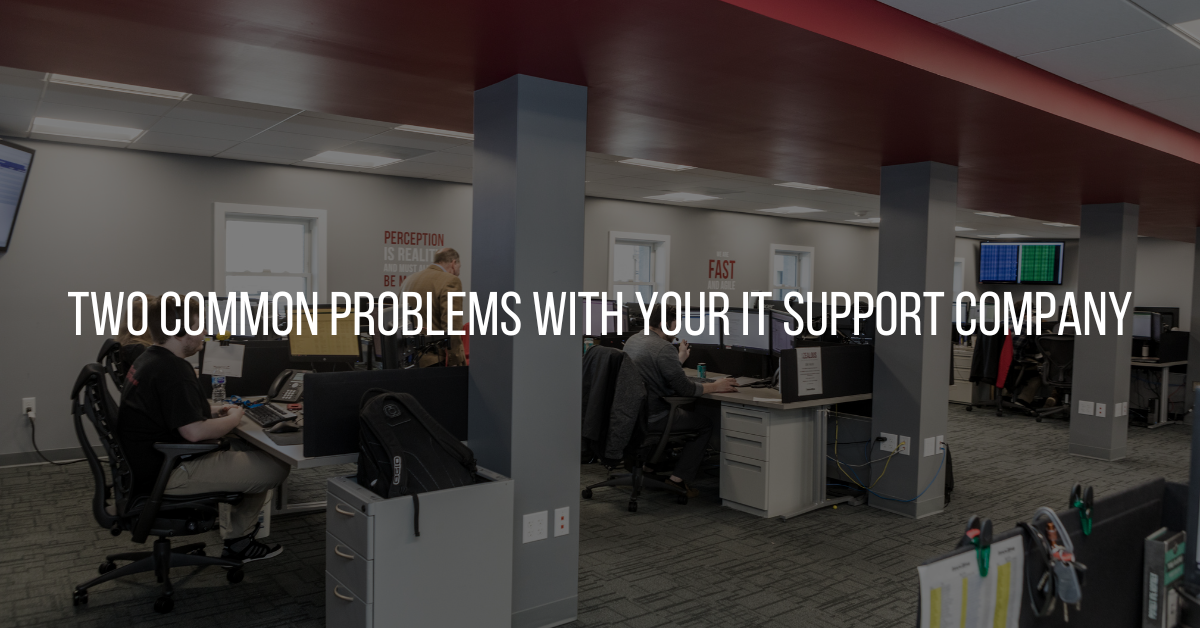Two Common Problems with Your IT Support Company
Technology Strategy | Business Strategy | Outsourced IT Support
You signed a contract with an IT support company and are relieved to have the weight of technology troubles lifted from your shoulders.
Not so fast.
You may be in for a bumpy ride.
We’ve heard all kinds of stories about why businesses are unhappy with their IT support vendor. Sometimes trouble creeps up over time as the service or the perception of service goes downhill. Other times the relationship is rocky from the start.
We’re not too proud to admit that we’ve had clients leave us in search of greener pastures. We’ve also acquired new clients leaving other providers with which they became unhappy.
Sometimes you need to leave your IT support provider (yes, even if it's us) when you outgrow one another or determine that your priorities and values are no longer aligned (or maybe they never were). Other times you can turn the relationship around with a little communication.
Some of the most common frustrations businesses have with their IT support company are easy to nip in the bud early with a little preparation and communication. Alternatively, you should identify areas of nonalignment before you enter into an IT support contract and select the best partner for your business objectives.
Of the complaints and frustrations we hear most often, two stand out as the most common complaints businesses have about their IT support company.
Unavailable, Slow to Respond, and Not There When You Need Them
There are two basic reasons your IT support company could be slow to respond to you.
- They don’t have the capacity or service commitment to meet your expectations; or
- They don’t fully understand the urgency of the problem.
You can easily address the first scenario through a Service Level Agreement (SLA). Most managed service providers include an SLA in their contract. If you don’t have one and you’re having trouble with response times, you should request one.
An SLA holds the IT support company accountable to defined response and resolution times.
While you probably don't want to go firing vendors for taking an extra 30 seconds to answer the phone one day, you should expect service well within the SLA timelines 99.9% of the time.
If you find your IT support company excessively missing their SLA deadlines, you should revisit this with them and make it clear that you expect them to meet their commitments. Whatever you do, don’t continue to accept service below the expectations to which you have agreed. That frustration will fester, and your relationship will most likely end badly after months of resentment.
You may be experiencing the second scenario if your IT support company seems to consistently miss their SLA timeline. Your support company may not understand the urgency of your requests and are classifying them incorrectly. This is EXACTLY why you should discuss even tiny issues as soon as they occur. You can easily solve this problem through clear communication.
Maybe your IT support company has committed to respond to critical issues in one hour or less and to lower priority issues in less than two hours. You’re consistently getting a response in an hour and a half and are frustrated because they’re missing their deadline by 30 minutes. Meanwhile, they are celebrating their success in responding to your issues 30 minutes ahead of the required deadline.
It takes time to learn your systems and critical business functions. Especially when you’re new to a company, their help desk techs may not identify a specific issue as critical unless you specifically say words like, “critical,” “system down,” or “emergency.”
For example, a user with lagging video streaming may not seem like an urgent issue to a help desk tech who gets an email stating, “my computer is having some intermittent video streaming issues.” This is a critical issue for a user monitoring a live video stream that is necessary to keep employees safe while working in high-risk environments. Another user experiencing the same issue might need to check in with her supervisor via video conference but can check-in at any point throughout the day without impacting the business. In this case, the same IT problem is critical in one case and non-urgent in the other. It’s important for the user experiencing the critical issue to communicate the priority level of the problem. This can be part of the learning curve of a new partnership, and you must address these communication issues if you expect to have the most beneficial partnership possible.
If you’re frustrated that your IT support company is unavailable or isn’t responding to you as quickly as you expect you should:
- Review your service level agreement and request one if you don’t have one.
- Reach out to your account manager or consultant to discuss areas where their team may be falling short on their promised response time.
- Discuss the flow of communication and identify any opportunities for improvement on either side of the relationship.
- Establish a separation strategy if it becomes apparent that your current IT support company is unable to support you the way you need.*
*Note: If you decide to separate from your current IT support company, identify a replacement before setting a contract termination date. The transition to a new provider goes much more smoothly with a 30-day overlap of service between your old company and new provider.
Too Expensive
IT support comes in a variety of service models and pricing options.
If you feel your IT support company is too expensive, you may be paying for a service that isn’t aligned with your business priorities, or you may not be aware of work they’re doing for you behind the scenes.
To choose the best IT support company for your business, start by evaluating what you want and need technology to do for you. Every company and type of service model brings something different to the table and fits different needs based on how your business uses technology. You want to choose a service model and company that aligns with the way you value and utilize technology.
Top-dollar IT support and consulting isn’t necessary for a cash-based business that keeps most records on paper. (Yes – those still exist!)
Alternatively, an accounting firm that maintains client tax records and depends on access to electronic data and communication systems has little to no room for error when it comes to maintaining and supporting their IT infrastructure.
The more essential IT systems and data security are to your business, the higher the stakes are for your IT support company, and the higher the cost of their services.
When you think of business IT support through that lens, you can find a company right-sized to the service you need and costs in line with the direct value brought to your business.
Start Off on the Right Foot
Getting these two common frustrations cleared up and addressed early in the game will drastically improve your odds at a successful relationship with your IT support company.
When frustrations do creep up over time, don't forget that a good partner is in it for your success. You can almost always resolve issues and frustrations through transparent communication and expectation management, as long as your goals and priorities align with your IT support company.



